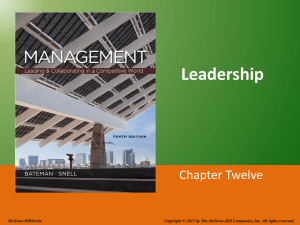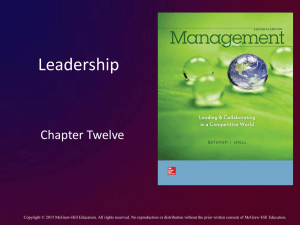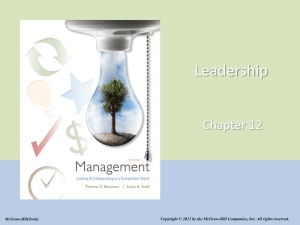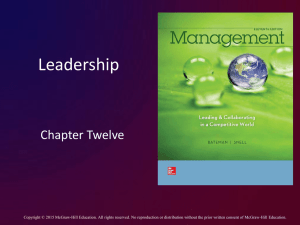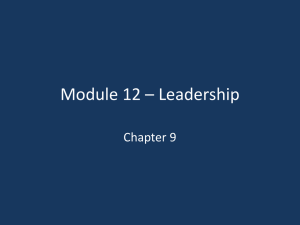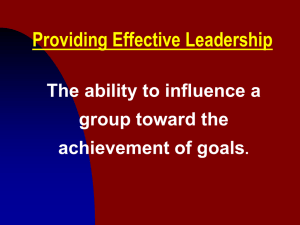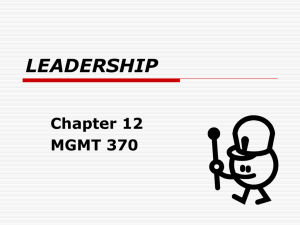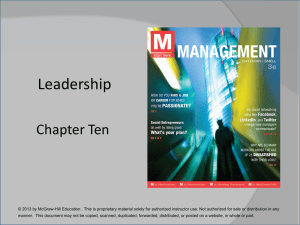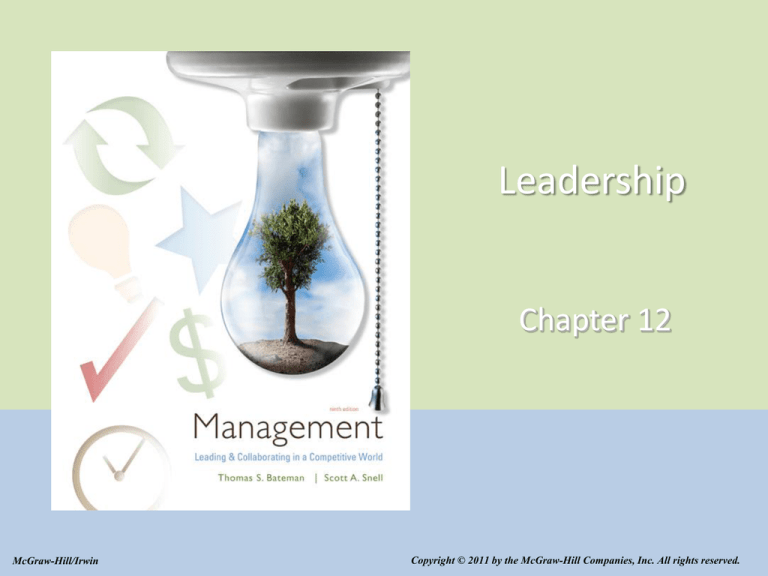
Leadership
Chapter 12
McGraw-Hill/Irwin
Copyright © 2011 by the McGraw-Hill Companies, Inc. All rights reserved.
Learning Objectives
LO 1 Discuss what it means to be a leader
LO 2 Summarize what people want and what
organizations need from their leaders
LO 3 Explain how a good vision helps you be a better
leader
LO 4 Identify sources of power in organizations
LO 5 List personal traits and skills of effective leaders
12-2
Learning Objectives (cont.)
LO 6 Describe behaviors that will make you a better
leader and identify when the situation calls for
them
LO 7 Distinguish between charismatic and
transformational leaders
LO 8 Describe types of opportunities to be a leader in
an organization
LO 9 Discuss how to further your own leadership
development
12-3
Leadership
Leader
One who influences others to attain goals.For
good or evil.
The greater the number of followers, the greater
the influence
Who is a follower?Why?
12-4
Key Leadership Behaviors
1.
2.
3.
4.
5.
Challenge the process
Inspire a shared vision
Enable others to act
Model the way---Is this true?
Encourage the heart
12-5
Vision
Vision
A mental image of a
possible and desirable
future state of the
organization.
Survive negatives
12-6
Leading and Managing
Supervisory
leadership
Behavior that provides
guidance, support, and
corrective feedback for
day-to-day activities.
Management
Strategic leadership
Behavior that gives
purpose and meaning
to organizations,
envisioning and
creating a positive
future.
12-7
Sources of Power
Legitimate
Coercive
Referent
Reward
Expert
12-8
Sources of Power
Figure 12.1
12-9
Traditional Approaches to
Understanding Leadership
Trait approach
A leadership perspective that attempts to
determine the personal characteristics that great
leaders share
12-10
Useful Leadership Characteristics
Drive
Leadership
Motivation
Integrity
Self
Confidence
Knowledge of
the Business
12-11
Ex. 11.2
Personal Characteristics of Leaders
Work-related characteristics
Physical characteristics Personality
Achievement drive, desire to excel
Energy
Self-confidence
Physical stamina
Honesty and integrity Conscientiousness in pursuit of goal
Persistence against obstacles, tenac
Enthusiasm
Desire to lead
Independence
Social background
Education
Intelligence and ability
Social characteristics
Judgment, cognitive ability Sociability, interpersonal skills Mobility
Knowledge
Cooperativeness
Judgment, decisiveness
Ability to enlist cooperation
Tact, diplomatic
© 2006 by South-Western, a division
of Thomson Learning. All rights
11-12
Characteristics of Effective Leaders
1. Driven, high achievers, passionate
2. Possess a strong desire to control others
3. Self-confident
4. Trustworthy and honest
5. Smart, knowledgeable, technically competent
6. Sensitive to people’s needs and feelings
7. Sense of humor
8. Emotionally intelligent
© 2006 by South-Western, a division
of Thomson Learning. All rights
11-13
Leader Behaviors
Behavioral approach
A leadership perspective that attempts to identify
what good leaders do—that is, what behaviors
they exhibit.
12-14
Leader Behaviors
Task performance behaviors
Actions taken to ensure that the work group or
organization reaches its goals.
WIIFM
12-15
Group Maintenance
Group maintenance
behaviors
Actions taken to
ensure the satisfaction
of group members,
develop and maintain
harmonious work
relationships, and
preserve the social
stability of the group
Leader-Member
Exchange (LMX)
theory
Highlights the
importance of leader
behaviors not just
toward the group as a
whole but toward
individuals on a
personal basis.
12-16
Questions Assessing Task Performance
and Group Maintenance Leadership
Table 12.1
12-17
Participation in Decision Making
Autocratic leadership
A form of leadership in which the leader makes
decisions on his or her own and then announces
those decisions to the group. My way or else!
Democratic leadership
A form of leadership in which the leader solicits
input from subordinates. How can we?
12-18
Participation in Decision Making
Laissez-faire leadership
philosophy
characterized by an
absence of managerial
decision making.
Hide-don’t rock the boat
12-19
Leadership Grid
Figure 12.2
12-20
Situational Approaches to Leadership
Situational approach
Leadership perspective proposing that universally
important traits and behaviors do not exist, and
that effective leadership behavior varies from
situation to situation.
Wars—problems-satisfaction
12-21
The Vroom Model of Leadership
Vroom model
A situational model
that focuses on the
participative
dimension of
leadership.
Figure 12.3
12-22
Situational Factors for
Problem Analysis
Table 12.2
12-23
Vroom’s Leader Decision Styles
Figure 12.3
12-24
Fiedler’s Contingency Model
Fiedler’s contingency model of leadership
effectiveness
A situational approach to leadership postulating
that effectiveness depends on the personal style
of the leader and the degree to which the
situation gives the leader power, control, and
influence over the situation.
12-25
Fiedler’s Analysis of Situations
Figure 12.4
12-26
Fiedler’s Contingency Model
Task-motivated
leadership
Leadership that places
primary emphasis on
completing a task.
Get it done
Relationshipmotivated leadership
Leadership that places
primary emphasis on
maintaining good
interpersonal
relationships.
Your friend
12-27
Hersey and Blanchard’s Situational Theory
Hersey and Blanchard’s situational theory
A life-cycle theory of leadership postulating that a
manager should consider an employee’s
psychological and job maturity before deciding
whether task performance or maintenance
behaviors are more important.
12-28
Ex. 11.1
Leader and Manager Qualities
SOURCE: Based on Genevieve
Capowski, “Anatomy of a Leader:
Where Are the Leaders of
Tomorrow?” Management Review,
March 1994, 12.
© 2006 by South-Western, a division
of Thomson Learning. All rights
11-29
Hersey and Blanchard’s Situational Theory
Job maturity
The level of the
employee’s skills and
technical knowledge
relative to the task
being performed.
Psychological
maturity
An employee’s selfconfidence and selfrespect.
12-30
Path-Goal Theory
Path-goal theory
A theory that concerns how leaders influence
subordinates’ perceptions of their work goals and
the paths they follow toward attainment of those
goals.
12-31
The Path-Goal Framework
Figure 12.5
12-32
Substitutes for Leadership
Substitutes for
leadership
Factors in the
workplace that can
exert the same
influence on
employees as leaders
would provide.
12-33
Contemporary Perspectives on Leadership
Charismatic leader
A person who is dominant, self-confident,
convinced of the moral righteousness of his
beliefs, and able to arouse a sense of excitement
and adventure in followers.
Follow anywhere
12-34
Contemporary Perspectives on Leadership
Transformational leader
A leader who motivates people to transcend their
personal interests for the good of the group.
Transactional leaders
Leaders who manage through transactions, using
their legitimate, reward, and coercive powers to
give commands and exchange rewards for services
rendered.
12-35
Contemporary Perspectives on Leadership
Level 5 leadership
A combination of strong professional will
(determination) and humility that builds enduring
greatness.
Others
12-36
Authenticity
Authentic leadership
A style in which the
leader is true to
himself or herself
while leading
Pseudotransformational
leaders
Leaders who talk
about positive change
but allow their selfinterest to take
precedence over
followers’ needs
Hypocrite
12-37
Opportunities for Leaders
Servant-leader
A leader who serves
others’ needs while
strengthening the
organization.
Bridge leaders
A leader who bridges
conflicting value
systems or different
cultures.
12-38
Opportunities for Leaders
Shared leadership
Rotating leadership, in
which people rotate
through the leadership
role based on which
person has the most
relevant skills at a
particular time.
Lateral leadership
Style in which
colleagues at the same
hierarchical level are
invited to collaborate
and facilitate joint
problem solving.
12-39
Causes of Work Stress
Four Categories:
Demands associated with job tasks.
Physical demands.
Roles demands (Sets of expected behaviors).
Interpersonal demands.
© 2006 by South-Western, a division
of Thomson Learning. All rights
11-40
Five Proven Stress Busters
Take a brief break from a stressful situation and do something
small and constructive, like washing your car or getting a hair
cut.
Get help with a stressful task from a co-worker, boss, or friend.
Concentrate intensely on reading, surfing the Internet, a sport,
or hobby. Contrary to common sense, concentration is at the
heart of stress reduction.
Finish anything you have started. Accomplishing almost
anything reduces some stress.
Find somebody or something that makes you laugh, and have a
good laugh.
© 2006 by South-Western, a division
of Thomson Learning. All rights
11-41
Increasing Productivity Through
Delegation and Empowerment
8. Allow for
spending money
and using
resources
1. Assign
duties to the
right people
7. Step back
from the
details
6. Delegate
both pleasant
and unpleasant
tasks
5. Obtain
feedback on
the delegated
© 2006 by South-Western, a division task
of Thomson Learning. All rights
2. Delegate the
whole task
3. Give as
much
instruction as
needed
4. Retain some
important
tasks for
yourself
11-42

